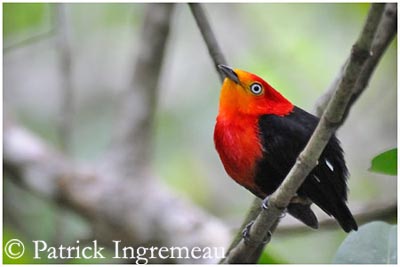
Crimson-hooded Manakin
Pipra aureola
Passeriforme Order – Pipridae Family
BIOMETRICS:
Length : 11 cm
Weight : 14-18 g
DESCRIPTION:
Crimson-hooded Manakin, as other manakins’ species, performs spectacular displays with other males in a lek on low branches.
Fr: Manakin aureole
All : Rothaubenpipra
Esp : Saltarín Cabecinaranja
Ital : Manachino cappuccio rosso
Nd : Roodkruinmanakin
Photographs by Patrick Ingremeau
His website: TAMANDUA
Photographs by Maxime Dechelle
His website: LEPAPARRAZO
Text by Nicole Bouglouan
Sources:
HANDBOOK OF THE BIRDS OF THE WORLD VOL 9 by Josep del Hoyo - Andrew Elliot - David Christie - Lynx Edicions - ISBN: 8487334695
Arthur Grosset's Birds (Arthur Grosset)

Crimson-hooded Manakin adult male has black plumage on back, rump, wings, tail and belly. Underwing and undertail feathers are black too.
Vent shows some orange tinge. Thighs are yellowish-white.
Face, chin and throat are orange-yellow. Crown, nape, upper mantle, neck sides and breast are crimson.
Bill is blackish, with paler grey lower mandible. Eyes are whitish to white. Legs and feet are dark pinkish.
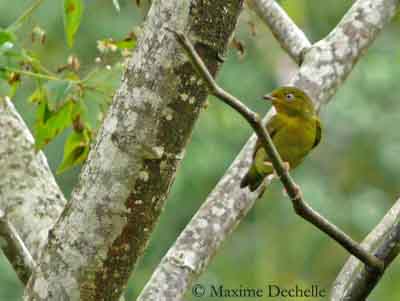
Female is very different with olive-green plumage overall. Lores, chin and throat are washed yellow, and breast shows yellowish streaks. Belly, vent and undertail coverts are pale grey. She has pale greyish eyes.
Immature is similar to female, but it has darker eyes.
We find four subspecies:
P.a. aureola, very similar.
P.a. flavicollis has neat forehead well demarcated from the crown. Yellow extends to the breast.
P.a. aurantiicollis has very narrow yellow frontal band, and throat is darker yellow.
P.a. borbae has broader yellow forehead extending more and merging with the red feathers of the crown.
VOICE: SOUNDS BY XENO-CANTO
Crimson-hooded Manakin produces wing noises during the displays. We can hear a soft “kloop” at the lowest part of the flight, before to alight on the perch with a “clik”.
The male’s call is a plaintive “eeeew”, but it also utters a sharp “chee-weep”.
HABITAT:
Crimson-hooded Manakin is resident in humid areas such as swamps, woodlands along rivers and seasonally flooded forests. It is also found in mangroves in some parts of its range, mainly along the coast.
It is visible up to 300 metres, but locally, as in Venezuela, it may be found up to 1200 metres of elevation.
RANGE:
Crimson-hooded Manakin is found in Brazil, the Guianas, Suriname and Venezuela.
BEHAVIOUR:
Crimson-hooded Manakin feeds on small fruits, insects and spiders. Fruits are plucked, and insects are caught by aerial sallies from perches.
The manakins have large gape, and they are able to swallow relatively large fruits.
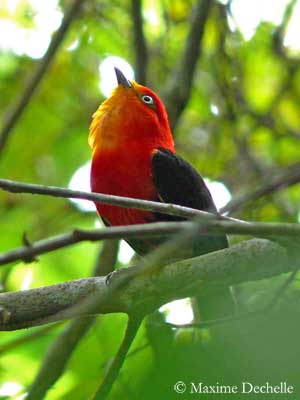
During the breeding season, the Crimson-hooded Manakin performs elaborated displays, as other manakins’ species.
Male performs displays with other males in a lek or mating perch. There are one dominant male and subordinates. Only the dominant or “alpha male” mates with the females coming to the perch. The “beta males” are younger.
Between other figures, the most spectacular consists of alternating flight displays, performed by several males.
In rapid succession, each male flies and alights on the perch. When another bird approaches, the first leaves the place and flies back to the previous perch, at about 20 metres away. These displays may continue during several minutes.
In the main phase, the male raises its tail and joins the female on the mating perch. The wings of males produce varied sounds during the flight displays.
Crimson-hooded Manakin males are resident in their range. The established males spend most of their time at their mating perches. They made brief foraging excursions, and come back quickly to their perch. The younger males move around.
FLIGHT:
Crimson-hooded Manakin has agile flight during the courtship displays. These flights are very rapid and complex.
REPRODUCTION:
Breeding season varies according to the range.
Manakins are solitary nesters, and males do not take part in nesting duties.
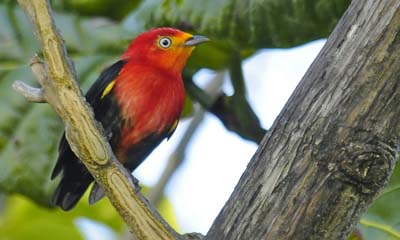
The nest is small and well camouflaged into vegetation. It is a small open cup situated in a fork between two twigs, in a shrub, at only one metre above the ground. The cup is made with plant matter such as fibres, leaves, rootlets and fine materials.
Female lays two eggs. But there is no information about the nesting behaviour of this species.
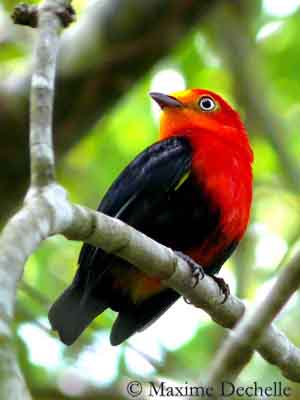
DIET:
Crimson-hooded Manakin feeds on small fruits (particularly of Araceae). It also consumes insects and spiders.
It performs aerial sallies from perches.
PROTECTION/THREATS/ STATUS:
Crimson-hooded Manakin is locally abundant in the coastal areas of the Guianas. In other parts of its range, it is rather uncommon.
However, this species is not threatened at this moment.